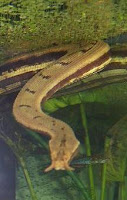Giant neurons and electrical synapses provide for short latency, but stereotyped responses. The non-giant circuit for repetitive tailflipping provides crayfish with flexibility and the potential for sustained escape.
I recall giving a lecture some years ago about crayfish escape responses, I remember trying to emphasize the importance of the non-giant neurons, saying to the students something like, “If you relied on just the giant neurons, which do the same things at every time, don’t you think that at some point, a predator would figure out, ‘If I attack here, the prey is going to end up here’?”
Turns out at least one predator has done just that – it’s just catching fish instead of crayfish.
Fish escape responses, like those of crayfish, are fast and controlled by a well-described set of neurons. The biggest neurons, the Mauthner cells, cause a very stereotyped behaviour when activated alone. If you play a loud sound to the fish’s right side, the Mauthner neuron triggers and sends a signal over to the fish’s left side, contracting muscles and causing the fish to turn away from the sound. (There are also sets of smaller neurons that allow for the fish’s escape to vary somewhat, but don't matter a lot for the purposes of this story, since they usually don’t change the overall right or left direction the fish turns; Foreman and Eaton, 1993).
 Somehow, tentacled snakes (Erpeton tentaculatum) have been able to take advantage of this predictable turn away from a loud sound. Somehow, the snake manages to move the trunk of their body just enough to make a vibration big enough to set off the fish’s escape response. This is one of the things I find most fascinating about this: the movement the snake makes is tiny! And it’s very surprising that this subtle little fast bend of the body is enough to set off an escape response. It’s a testament to the highly sensitive sensory systems of the fish.
Somehow, tentacled snakes (Erpeton tentaculatum) have been able to take advantage of this predictable turn away from a loud sound. Somehow, the snake manages to move the trunk of their body just enough to make a vibration big enough to set off the fish’s escape response. This is one of the things I find most fascinating about this: the movement the snake makes is tiny! And it’s very surprising that this subtle little fast bend of the body is enough to set off an escape response. It’s a testament to the highly sensitive sensory systems of the fish.The snake’s normal hunting position is a sort of J-shaped posture, so the head is roughly in the vicinity that the “escaping” (but actually probably doomed) fish will turn to. The snake isn’t as fast as the fish, so the snake has to start its strike in anticipation of the fish’s response and it aims for where it expects the fish to be after the fish makes its escape.
The fish’s escape behaviour isn’t completely stereotyped, though, and can be modulated by sensory input (Eaton and Emberley 1991). When the fish flips left instead of when it should flip “right,” it usually gets away.
Although Catania ends by saying this could be learned or innate (i.e., evolved), I’m guessing this behaviour is innate. It seems too specific to be learned afresh each generation, and that four snakes tested showed the behaviour would also seem to suggest a species specific evolved behaviour.
The article is open access, and has lot of supplemental video.
Hat tip to this article, which does a great job of summarizing the research and has a video compilation.
References
Catania, K. (2009). Tentacled snakes turn C-starts to their advantage and predict future prey behavior Proceedings of the National Academy of Sciences DOI: 10.1073/pnas.0905183106
Eaton RC, Emberley DS. 1991. How stimulus direction determines the trajectory of the Mauthner-initiated escape response in a teleost fish. J. Exp. Biol. 161(1): 469-487.
Foreman MB, Eaton RC. 1993. The direction change concept for reticulospinal control of goldfish escape. J. Neurosci. 13: 4101-4114.

No comments:
Post a Comment